LAI-Derived Atmospheric Moisture Condensation Potential for Forest Health and Land Use Management
Abstract
1. Introduction
2. Materials and Methods
2.1. Study Area
2.2. Study Flow Chart and Data Acquisition
2.3. Fundamental Principles
2.3.1. Psychrometric Chart and Condensation
2.3.2. Thermodynamic Principles and Key Formulas
2.4. Atmospheric Moisture Condensation
2.4.1. Nocturnal Condensation Potential Index
2.4.2. Kriging Interpolation of the NCPI
2.4.3. Empirical Dew Model
2.5. LAI-Derived Condensation Potential and Management Suitability
2.6. Pairwise Correlation of the LULC
2.7. Groundwater Potential as a Comparative Baseline
3. Results
3.1. Spatiotemporal Dynamics of the NCPI, LAI, and MSS
3.1.1. NCPI and Kriging Interpolation
3.1.2. Distribution and Classification of the LAI
3.1.3. Identification of Management Suitability Prioritization
3.2. Pairwise Correlation and Plot Visualizations of the LULC Metrics
3.3. Temporal MSS Changes and Empirical Dew Yield of Field Sites in LULUCF Areas
3.4. Validation of the MSS Independence Using GWP
4. Discussion
4.1. Implications of the MSS Dynamics for Ecosystem Management
4.2. Limitations and Future Research
5. Conclusions
Author Contributions
Funding
Data Availability Statement
Acknowledgments
Conflicts of Interest
Abbreviations
| AMC | Atmospheric moisture condensation |
| ASTER GDEM | Advanced Spaceborne Thermal Emission and Reflection Radiometer Global Digital Elevation Model |
| CWA | Central Weather Administration |
| DD | Drainage density |
| DEM | Digital elevation model |
| FA | Flow accumulation |
| GIS | Geographic information system |
| GWP | Groundwater potential |
| GSMMA | Geological Survey and Mining Management Agency |
| HGU | Hydrogeological units |
| IQR | Interquartile range |
| LAI | Leaf area index |
| LCP | LAI-derived condensation potential |
| LD | Lineament density |
| LOOCV | Leave-one-out cross-validation |
| LULC | Land use and land cover |
| LULUCF | The land-use, land-use change, and forestry |
| LST | Land surface temperature |
| LWP | Leaf water potential |
| MSS | Management suitability score |
| MSP | Management suitability prioritization |
| NASA | National Aeronautics and Space Administration |
| NCPI | Nocturnal condensation potential index |
| NDVI | Normalized difference vegetation index |
| PCA | Principal component analysis |
| RH | Relative humidity |
| RMSE | Root mean square error |
| RS | Remote sensing |
| SD | Slope degree |
| SMI | Soil moisture index |
| TWI | Topographic wetness index |
| USGS | United States Geological Survey |
| VPD | Vapor pressure deficit |
References
- Tenkanen, M.K.; Tsuruta, A.; Tyystjärvi, V.; Törmä, M.; Autio, I.; Haakana, M.; Tuomainen, T.; Leppänen, A.; Markkanen, T.; Raivonen, M.; et al. Using atmospheric inverse modelling of methane budgets with Copernicus land water and wetness data to detect land use-related emissions. Remote Sens. 2024, 16, 124. [Google Scholar] [CrossRef]
- Cheng, H.; Park, C.Y.; Cho, M.; Park, C. Water requirement of urban green infrastructure under climate change. Sci. Total Environ. 2023, 893, 164887. [Google Scholar] [CrossRef]
- Wu, H.; Long, B.; Huang, N.; Lu, N.; Qian, C.; Pan, Z.; Men, J.; Zhang, Z. Impacts of climate change on ecological water use in the Beijing–Tianjin–Hebei region in China. Water 2024, 16, 319. [Google Scholar] [CrossRef]
- Bock, A.D.; Belmans, B.; Vanlanduit, S.; Blom, J. Alvarado-Alvarado, A.A.; Audenaert, A. A review on the leaf area index (LAI) in vertical greening systems. Build. Environ. 2023, 229, 109926. [Google Scholar] [CrossRef]
- Gao, Z.; Chen, Y.; Zhang, Z.; Duan, T.; Chen, J.; Li, A. Continuous leaf area index (LAI) observation in forests: Validation, application, and improvement of LAI-NOS. Forests 2024, 15, 868. [Google Scholar] [CrossRef]
- Gavilán-Acuna, G.; Coops, N.C.; Tompalski, P.; Mena-Quijada, P.; Varhola, A.; Roeser, D.; Olmedo, G.F. Characterizing annual leaf area index changes and volume growth using ALS and satellite data in forest plantations. Sci. Remote Sens. 2024, 10, 100159. [Google Scholar] [CrossRef]
- Wang, Y.; Fang, H. Derivation and Evaluation of LAI from the ICESat-2 data over the NEON sites: The impact of segment size and beam type. Remote Sens. 2024, 16, 3078. [Google Scholar] [CrossRef]
- Zhen, Z.; Chen, S.; Yin, T.; Chavanon, E.; Lauret, N.; Guilleux, J.; Henke, M.; Qin, W.; Cao, L.; Li, J.; et al. Using the negative soil adjustment factor of soil adjusted vegetation Index (SAVI) to resist saturation effects and estimate leaf area index (LAI) in dense vegetation areas. Sensors 2021, 21, 2115. [Google Scholar] [CrossRef]
- Cui, J.; Lian, X.; Huntingford, C.; Gimeno, L.; Wang, T.; Ding, J.; He, M.; Xu, H.; Chen, A.; Gentine, P.; et al. Global water availability boosted by vegetation-driven changes in atmospheric moisture transport. Nat. Geosci. 2022, 15, 982–988. [Google Scholar] [CrossRef]
- Reddy, P.S. Chapter 20—Breeding for Abiotic Stress Resistance in Sorghum. In Woodhead Publishing Series in Food Science, Technology and Nutrition, Breeding Sorghum for Diverse End Uses; Aruna, C., Visarada, K.B.R.S., Bhat, B.V., Tonapi, V.A., Eds.; Woodhead Publishing: Sawston, UK, 2019; pp. 325–340. [Google Scholar] [CrossRef]
- Diatta, A.A.; Min, D.; Jagadish, K.S.V. Chapter Two—Drought stress responses in non-transgenic and transgenic alfalfa—Current status and future research directions. Adv. Agron. 2021, 170, 35–100. [Google Scholar] [CrossRef]
- Hussain, M.; Farooq, S.; Hasan, W.; Ul-Allah, S.; Tanveer, M.; Farooq, M.; Nawaz, A. Drought stress in sunflower: Physiological effects and its management through breeding and agronomic alternatives. Agric. Water Manag. 2018, 201, 152–166. [Google Scholar] [CrossRef]
- Liou, Y.-A.; Thai, M.-T. Surface water availability and temperature (SWAT): An innovative index for remote sensing of drought observation. IEEE Trans. Geosci. Remote Sens. 2023, 61, 4507312. [Google Scholar] [CrossRef]
- Thai, M.-T.; Liou, Y.-A. Advancements in the temperature-soil moisture dryness index (TMDI) for drought monitoring in southwestern Taiwan. IEEE Trans. Geosci. Remote Sens. 2024, 62, 4405415. [Google Scholar] [CrossRef]
- Li, Z.-K.; Gong, X.-W.; Wang, J.-L.; Chen, Y.-D.; Liu, F.-Y.; Li, H.-P.; Lü, G.-H. Foliar water uptake improves branch water potential and photosynthetic capacity in Calligonum mongolicum. Ecol. Indic. 2023, 146, 109825. [Google Scholar] [CrossRef]
- Pinter, P.J., Jr. Effect of dew on canopy reflectance and temperature. Agric. For. Meteorol. 1986, 19, 187–205. [Google Scholar] [CrossRef]
- Gerlein-Safdia, C.; Koohafkan, M.C.; Chung, M.; Rockwell, F.E.; Thompson, S.; Caylor, K.K. Dew deposition suppresses transpiration and carbon uptake in leaves. Agric. For. Meteorol. 2018, 259, 305–316. [Google Scholar] [CrossRef]
- Alnaser, W.E.; Barakat, A. Use of condensed water vapour from the atmosphere for irrigation in Barhein. Appl. Energy 2000, 65, 3–18. [Google Scholar] [CrossRef]
- Kidron, G.J.; Herrnstadt, I.; Barzilay, E. The role of dew as a moisture source for sand microbiotic crusts in the Negev Desert, Israel. J. Arid Environ. 2002, 52, 517–533. [Google Scholar] [CrossRef]
- Duvdevani, S. Dew Gradients in relation to climate, soil and topography. In Proceedings of the International Symposium on Desert Research, Research Council of Israel, Jerusalem, Israel, 7–14 May 1952; Govt. Printer: Jerusalem, Israel, 1953; pp. 136–148. [Google Scholar]
- Lhomme, J.-P.; Jimenez, O.F. Estimating dew duration on banana and plantain leaves from standard meteorological observations. Agric. For. Meteorol. 1992, 62, 263–274. [Google Scholar] [CrossRef]
- Schmitz, H.F.; Grant, R.H. Precipitation and dew in a soybean canopy: Spatial variations in leaf wetness and implications for Phakopsora pachyrhizi infection. Agric. For. Meteorol. 2009, 149, 1621–1627. [Google Scholar] [CrossRef]
- Nilsson, T.M.J. Initial experiments on dew collection in Sweden and Tanzania. Sol. Energy Mater. Sol. Cells 1996, 40, 23–32. [Google Scholar] [CrossRef]
- Williams, D.W.; Powell, A.J., Jr.; Dougherty, C.T.; Vincelli, P. Separation and quantitation of the sources of dew on creeping bentgrass. Crop Sci. 1998, 38, 1613–1617. [Google Scholar] [CrossRef]
- Jacobs, A.F.G.; Heusinkveld, B.G.; Berkowicz, S.M. Dew deposition and drying in a desert system: A simple simulation model. J. Arid Environ. 1999, 42, 211–222. [Google Scholar] [CrossRef]
- Wilson, T.B.; Bland, W.L.; Norman, J.M. Measurement and simulation of dew accumulation and drying in a potato canopy. Agric. For. Meteorol. 1999, 93, 111–119. [Google Scholar] [CrossRef]
- Li, X.Y. Effects of gravel and sand mulches on dew deposition in the semiarid region of China. J. Hydrol. 2002, 260, 151–160. [Google Scholar] [CrossRef]
- Beysens, D.; Pruvost, V.; Pruvost, B. Dew observed on cars as a proxy for quantitative measurements. J. Arid Environ. 2016, 135, 90–95. [Google Scholar] [CrossRef]
- Vuollekoski, H.; Vogt, M.; Sinclair, V.A.; Duplissy, J.; Järvinen, H.; Kyrö, E.-M.; Makkonen, R.; Petäjä, T.; Prisle, N.L.; Räisänen, P.; et al. Estimates of global dew collection potential on artificial surfaces. Hydrol. Earth Syst. Sci. 2015, 19, 601–613. [Google Scholar] [CrossRef]
- Tomaszkiewicza, M.; Abou Najm, M.; Zurayk, R.; El-Fadela, M. Dew as an adaptation measure to meet water demand in agricultureand reforestation. Agric. For. Meteorol. 2017, 232, 411–421. [Google Scholar] [CrossRef]
- Atashi, N.; Rahimi, D.; Goortani, B.M.; Duplissy, J.; Vuollekoski, H.; Kulmala, M.; Vesala, T.; Hussein, T. Spatial and temporal investigation of dew potential based on long-term model simulations in Iran. Water 2019, 11, 2463. [Google Scholar] [CrossRef]
- Atashi, N.; Rahimi, D.; Al Kuisi, M.; Jiries, A.; Vuollekoski, H.; Kulmala, M.; Vesala, T.; Hussein, T. Modeling long-term temporal variation of dew formation in Jordan and its link to climate change. Water 2020, 12, 2186. [Google Scholar] [CrossRef]
- Muselli, M.; Lekouch, I.; Beysens, D. Physical and chemical characteristics of dew and rain in north-west Africa with focus on Morocco: Mapping past and future evolution (2005–2100). Atmosphere 2022, 13, 1974. [Google Scholar] [CrossRef]
- Muselli, M.; Beyens, D. Mapping past, present and future dew and rain water resources for biocrust evolution in southern Africa. J. Hydrol. Hydromech. 2021, 69, 400–420. [Google Scholar] [CrossRef]
- Lin, J.-J.; Arslan, A.N. Assessing the impact of land use on dew yield using remote sensing data in Taiwan. Int. Arch. Photogramm. Remote Sens. Spat. Inf. Sci. 2025, 48, 207–212. [Google Scholar] [CrossRef]
- Jia, Z.; Zhao, Z.; Zhang, Q.; Wu, W. Dew yield and its influencing factors at the Western Edge of Gurbantunggut Desert, China. Water 2019, 11, 733. [Google Scholar] [CrossRef]
- Aguirre-Gutiérrez, C.A.; Holwerda, F.; Goldsmith, G.R.; Delgado, J.; Yepez, E.; Carbajal, N.; Escoto-Rodríguez, M.; Arredondo, J.T. The importance of dew in the water balance of a continental semiarid Grassland. J. Arid Environ. 2019, 168, 26–35. [Google Scholar] [CrossRef]
- Binks, O.; Finnigan, J.; Coughlin, I.; Disney, M.; Calders, K.; Burt, A.; Vicari, M.B.; da Costa, A.L.; Mencuccini, M.; Meir, P. Canopy wetness in the Eastern Amazon. Agric. For. Meteorol. 2021, 297, 108250. [Google Scholar] [CrossRef]
- Cosh, M.H.; Kabela, E.D.; Hornbuckle, B.; Gleason, M.L.; Jackson, T.J.; Prueger, J.H. Observations of dew amount using in situ and satellite measurements in an agricultural landscape. Agric. For. Meteorol. 2009, 149, 1082–1086. [Google Scholar] [CrossRef]
- Heusinkveld, B.G.; Berkowicz, S.M.; Jacobs, A.F.G.; Hillen, W.; Holtslag, A.A.M. A new remote optical wetness sensor and its applications. Agric. For. Meteorol. 2008, 148, 580–591. [Google Scholar] [CrossRef]
- Xu, Y.; Dou, Y.; Yu, Y.; Yang, X. The dew particle interception abilities of typical plants in Northeast China plant leaves capture particles in dew. Adv. Meteorol. 2022, 2022, 7157012. [Google Scholar] [CrossRef]
- Madeira, A.C.; Kim, K.S.; Taylor, S.E.; Gleason, M.L. A simple cloud-based energy balance model to estimate dew. Agric. For. Meteorol. 1999, 111, 55–63. [Google Scholar] [CrossRef]
- Kuwagata, T.; Maruyama, A.; Kondo, J.; Watanabe, T. Theoretical study on dew formation in plant canopies based on a one-layer energy-balance model. Agric. For. Meteorol. 2024, 354, 109911. [Google Scholar] [CrossRef]
- Gillespie, T.J.; Brisco, B.; Brown, R.J.; Sofko, G.J. Radar detection of a dew event in wheat. Remote Sens. Environ. 1990, 33, 151–156. [Google Scholar] [CrossRef]
- Schneebeli, M.; Wolf, S.; Kunert, N.; Eugster, W.; Mätzler, C. Relating the X-band opacity of a tropical tree canopy to sapflow, rain interception and dew formation. Remote Sens. Environ. 2011, 115, 2116–2125. [Google Scholar] [CrossRef]
- Glanville, K.; Sheldon, F.; Butler, D.; Capon, S. Effects and significance of groundwater for vegetation: A systematic review. Sci. Total Environ. 2023, 875, 162577. [Google Scholar] [CrossRef]
- El-Hokayem, L.; De Vita, P.; Usman, M.; Link, A.; Conrad, C. Mapping potentially groundwater-dependent vegetation in the Mediterranean biome using global geodata targeting site conditions and vegetation characteristics. Sci. Total Environ. 2023, 898, 166397. [Google Scholar] [CrossRef]
- Nguyen, K.-A.; Liou, Y.-A. Global mapping of eco-environmental vulnerability from human and nature disturbances. Sci. Total Environ. 2019, 664, 995–1004. [Google Scholar] [CrossRef]
- Teodoro, A.C.; Duarte, L. Chapter 11—The synergy of remote sensing and geographical information systems in the management of natural disasters. In Micro and Nano Technologies, Nanotechnology-Based Smart Remote Sensing Networks for Disaster Prevention; Denizli, A., Alencar, M.S., Nguyen, T.A., Motaung, D.E., Eds.; Elsevier: Amsterdam, The Netherlands, 2022; pp. 217–230. [Google Scholar] [CrossRef]
- Lin, J.-J.; Liou, Y.-A. Integrating In-Situ Data and RS-GIS Techniques to Identify Groundwater Potential Sites in Mountainous Regions of Taiwan. Appl. Sci. 2020, 10, 4119. [Google Scholar] [CrossRef]
- Abera, K.A.; Gebreyohannes, T.; Abrha, B.; Hagos, M.; Berhane, G.; Hussien, A.; Belay, A.S.; Van Camp, M.; Walraevens, K. Vulnerability mapping of groundwater resources of Mekelle City and surroundings, Tigray region, Ethiopia. Water 2022, 14, 2577. [Google Scholar] [CrossRef]
- Ponette-González, A.G.; Brauman, K.A.; Marín-Spiotta, E.; Farley, K.A.; Weathers, K.C.; Young, K.R.; Curran, L.M. Managing water services in tropical regions: From land cover proxies to hydrologic fluxes. Ambio 2015, 44, 367–375. [Google Scholar] [CrossRef]
- Niu, G.; Kozai, T.; Sabeh, N. Chapter 11—Physical environmental factors and their properties. In Plant Factory, 2nd ed.; Kozai, T., Niu, G., Takagaki, M., Eds.; Academic Press: Cambridge, MA, USA, 2020; pp. 185–195. [Google Scholar] [CrossRef]
- Hundy, G.F.; Trott, A.R.; Welch, T.C. Chapter 19—Air and Water Vapour Mixtures. In Refrigeration, Air Conditioning and Heat Pumps, 5th ed.; Hundy, G.F., Trott, A.R., Welch, T.C., Eds.; Butterworth-Heinemann: Oxford, UK, 2016; pp. 301–312. [Google Scholar] [CrossRef]
- Alduchov, O.A.; Eskridge, R.E. Improved Magnus form approximation of saturation vapour pressure. J. Appl. Meteor. 1996, 35, 601–609. [Google Scholar] [CrossRef]
- Koutsoyiannis, D. Clausius–Clapeyron equation and saturation vapour pressure: Simple theory reconciled with practice. Eur. J. Phys. 2012, 33, 295. [Google Scholar] [CrossRef]
- Jenks, G.F. The data model concept in statistical mapping. Int. Yearb. Cartogr. 1967, 7, 186–190. [Google Scholar]
- Wang, C.-W. The Observation and Model Simulation of Valley Boundary Layer. Master’s Thesis, National Taiwan University, Taipei, Taiwan, 2011. [Google Scholar] [CrossRef]
- Tian, J.; Li, Z.; Wang, H.; Lv, G.; Li, W.; Wang, H.; Wang, Y. Physiological responses and ecological benefits of water uptake by Populus euphratica leaves in arid areas. Forests 2024, 15, 430. [Google Scholar] [CrossRef]
- Boanares, D.; Jovelina da-Silva, C.; Mary Dos Santos Isaias, R.; Costa França, M.G. Oxidative metabolism in plants from Brazilian rupestrian fields and its relation with foliar water uptake in dry and rainy seasons. Plant Physiol. Biochem. 2020, 146, 457–462. [Google Scholar] [CrossRef]

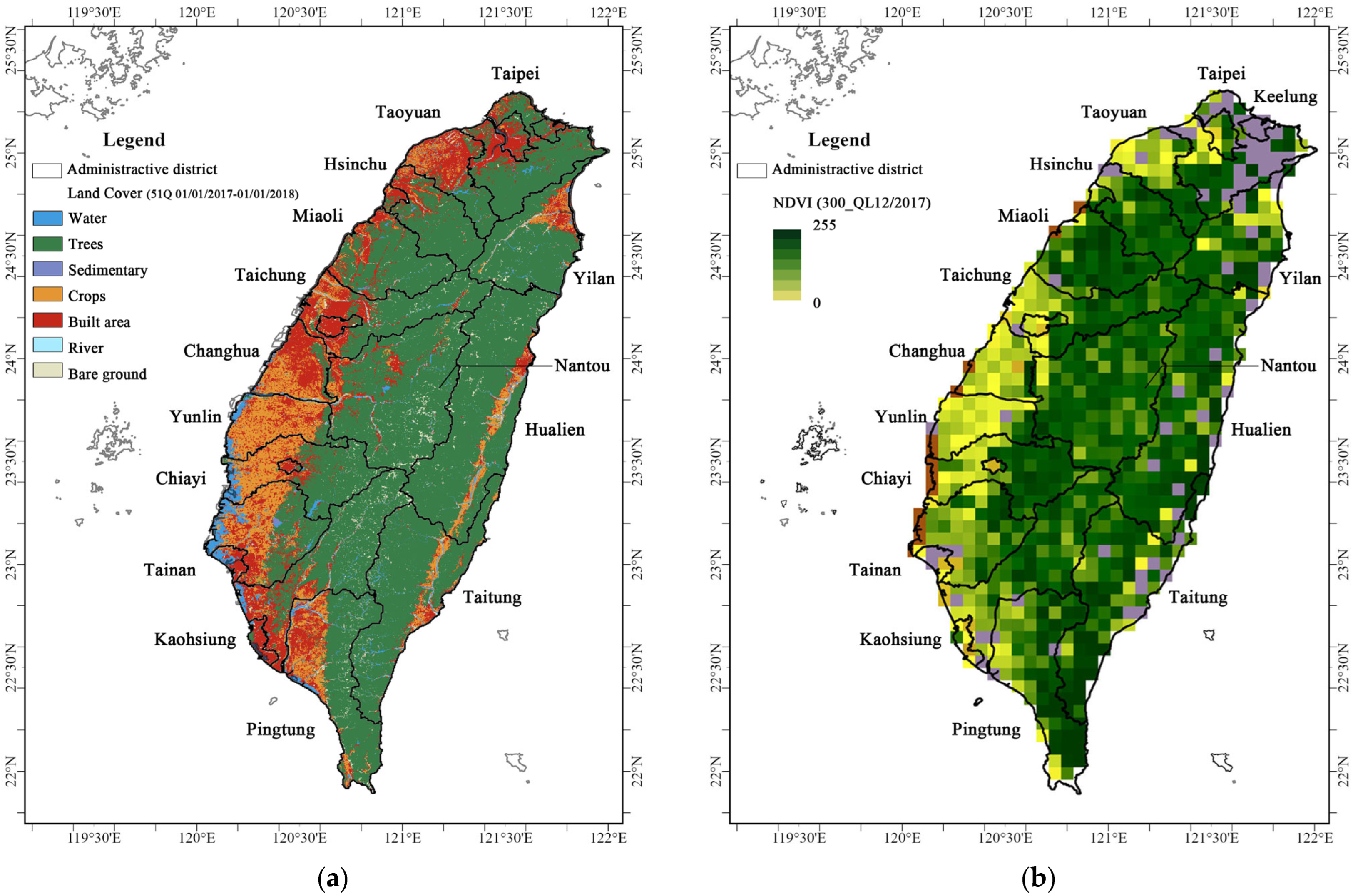
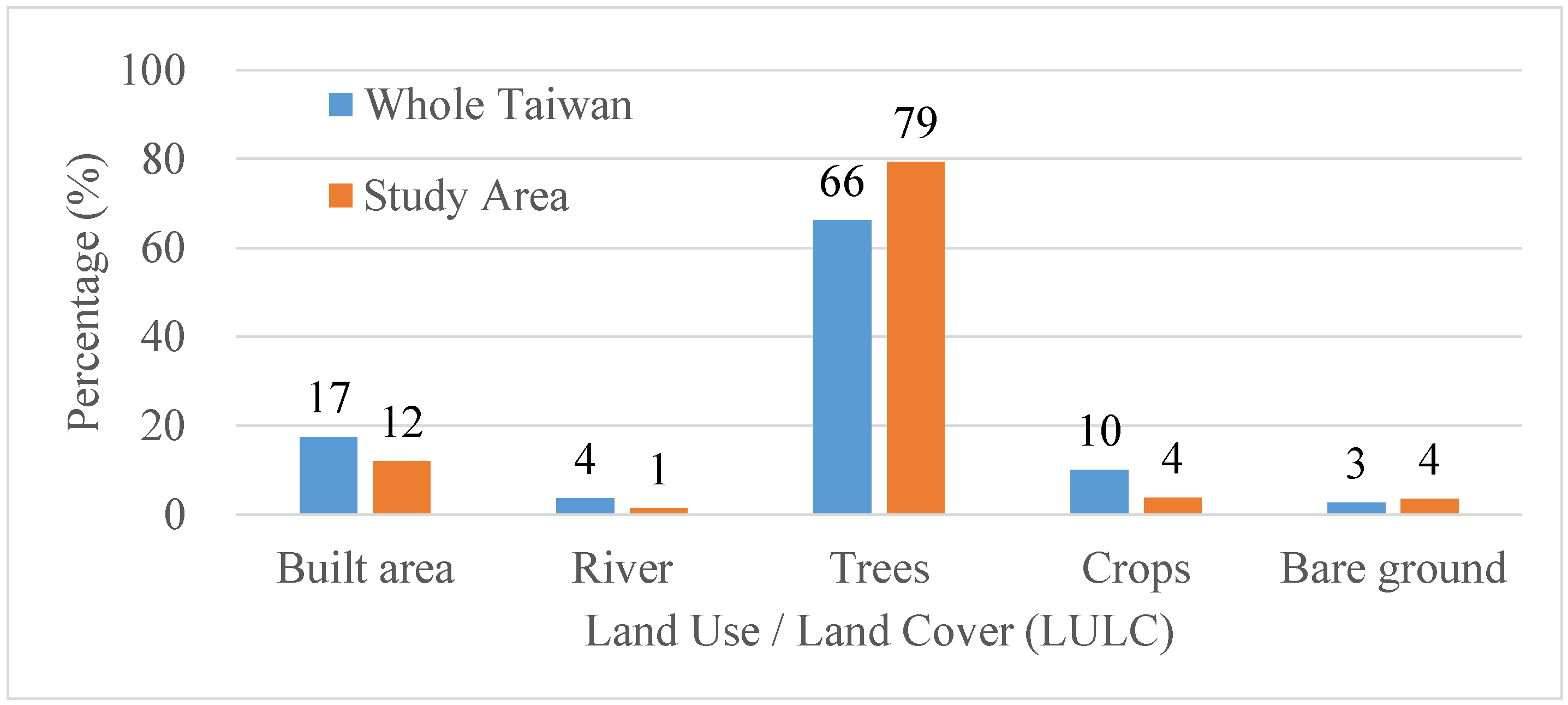
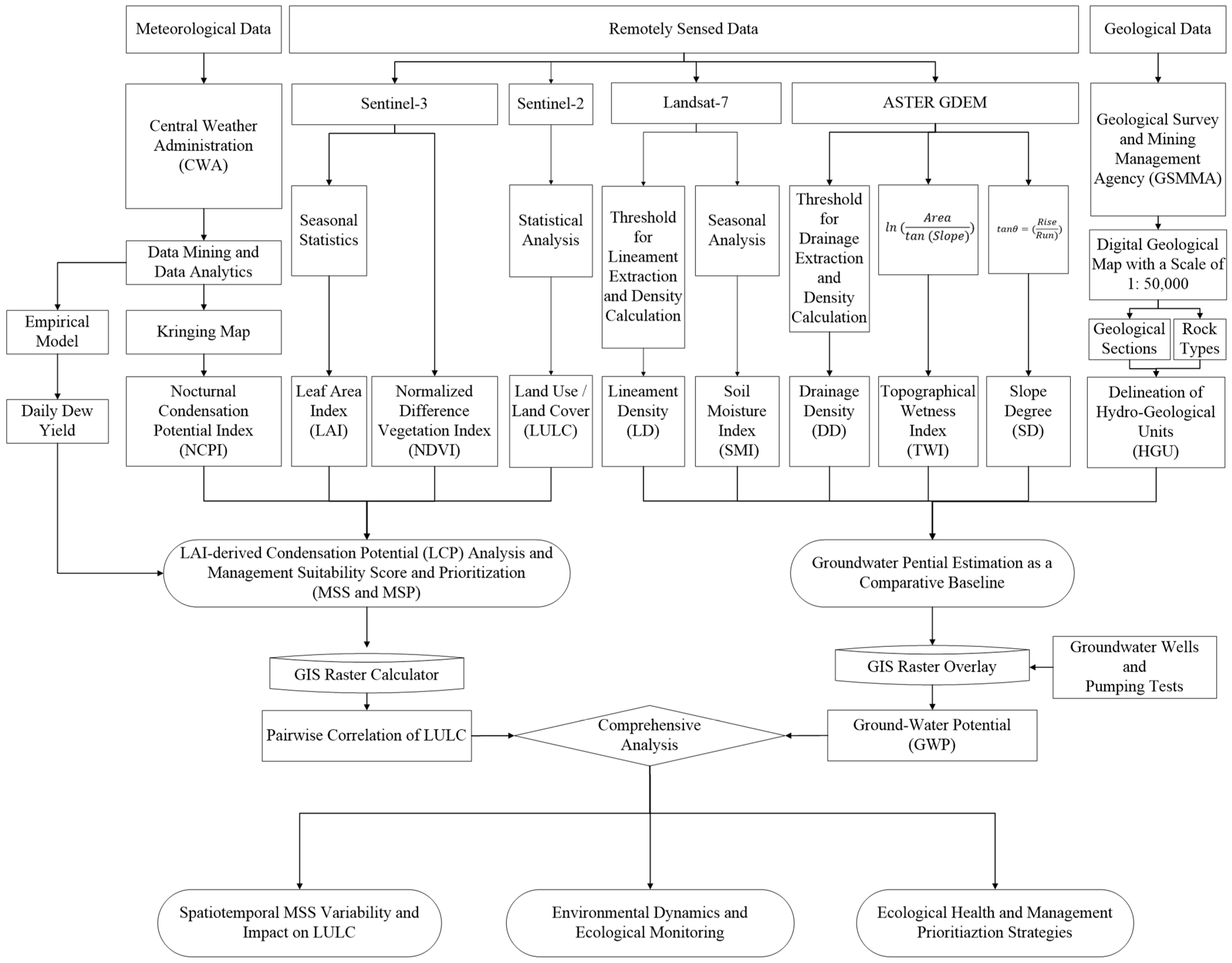
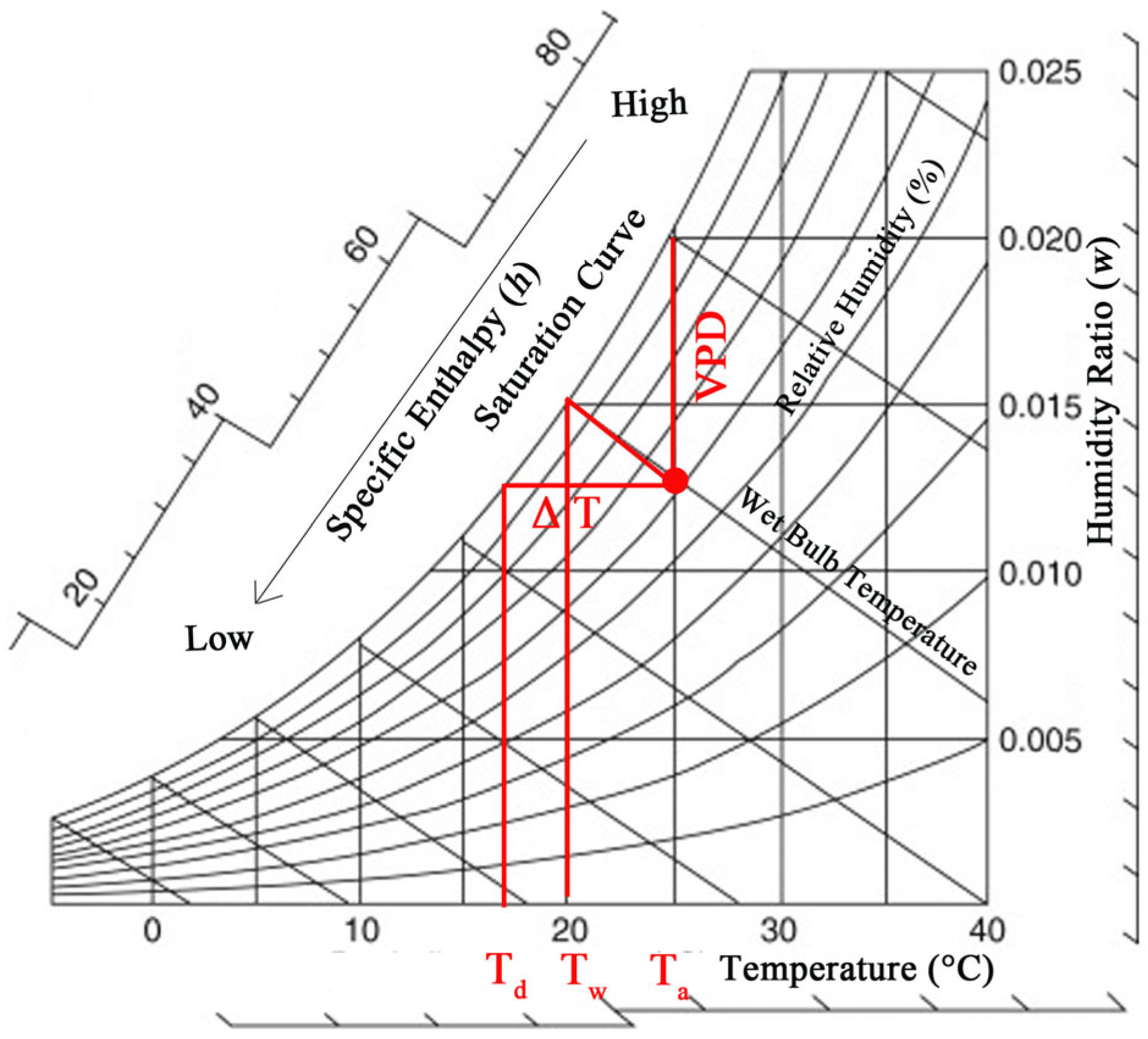

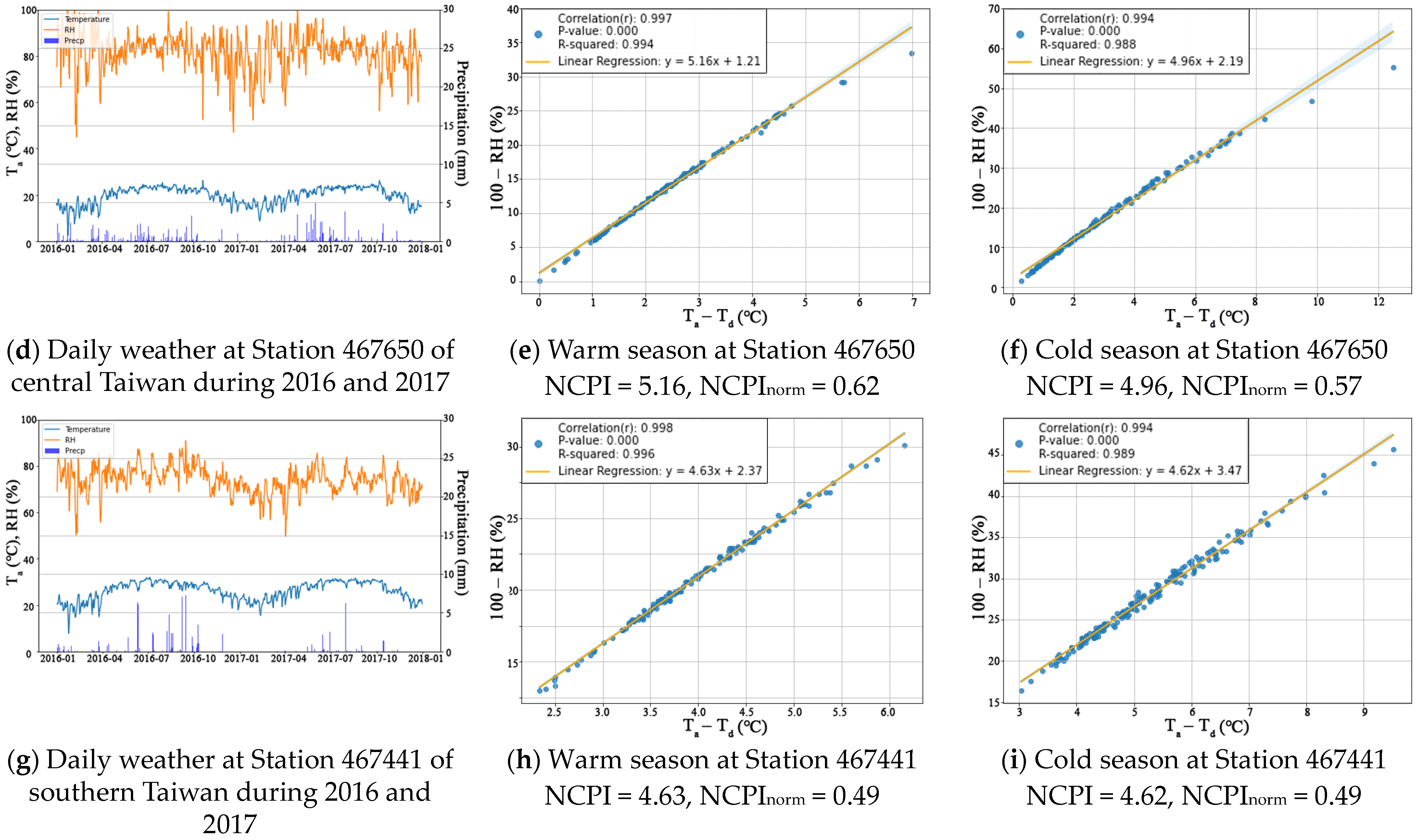
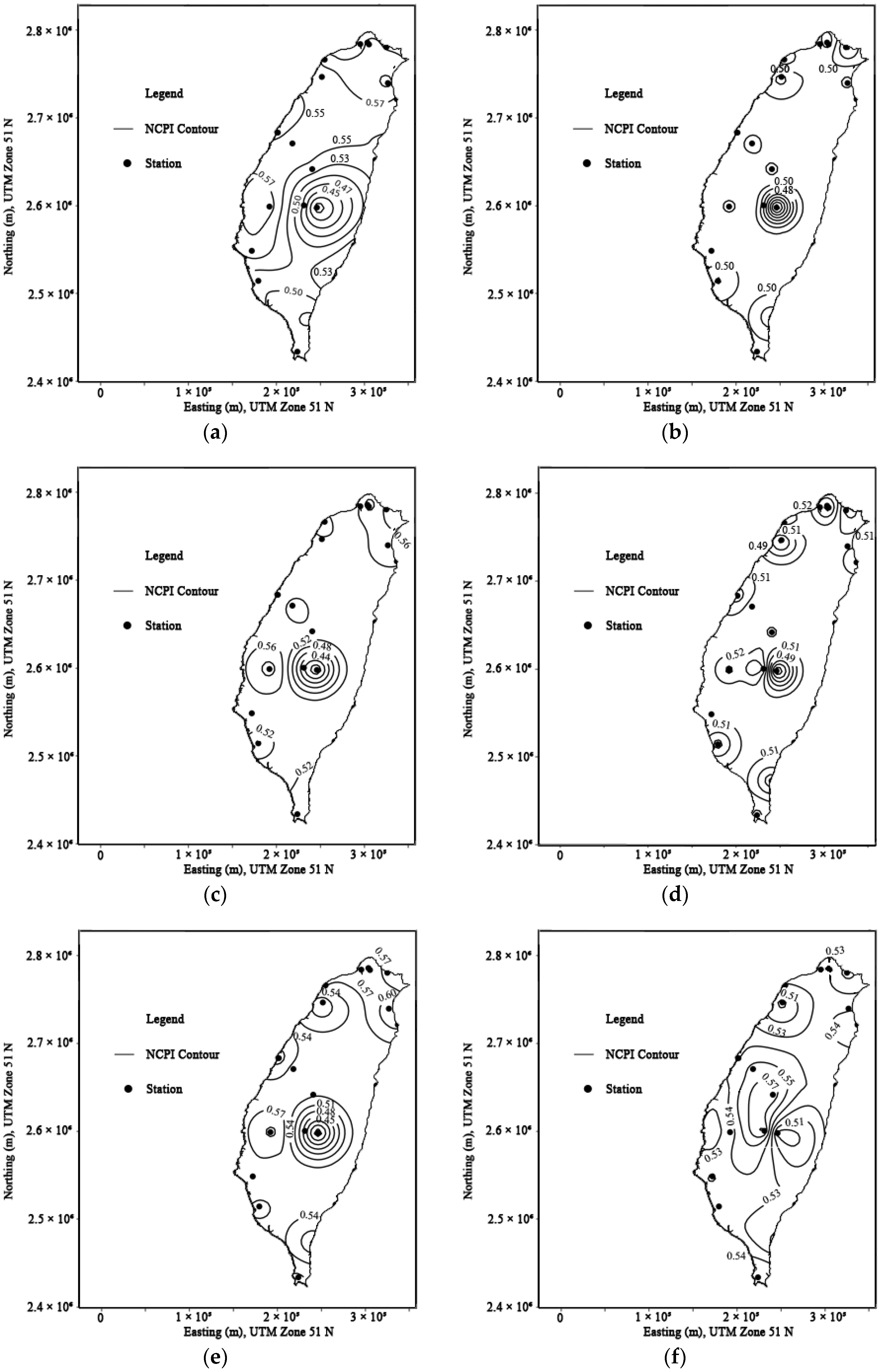



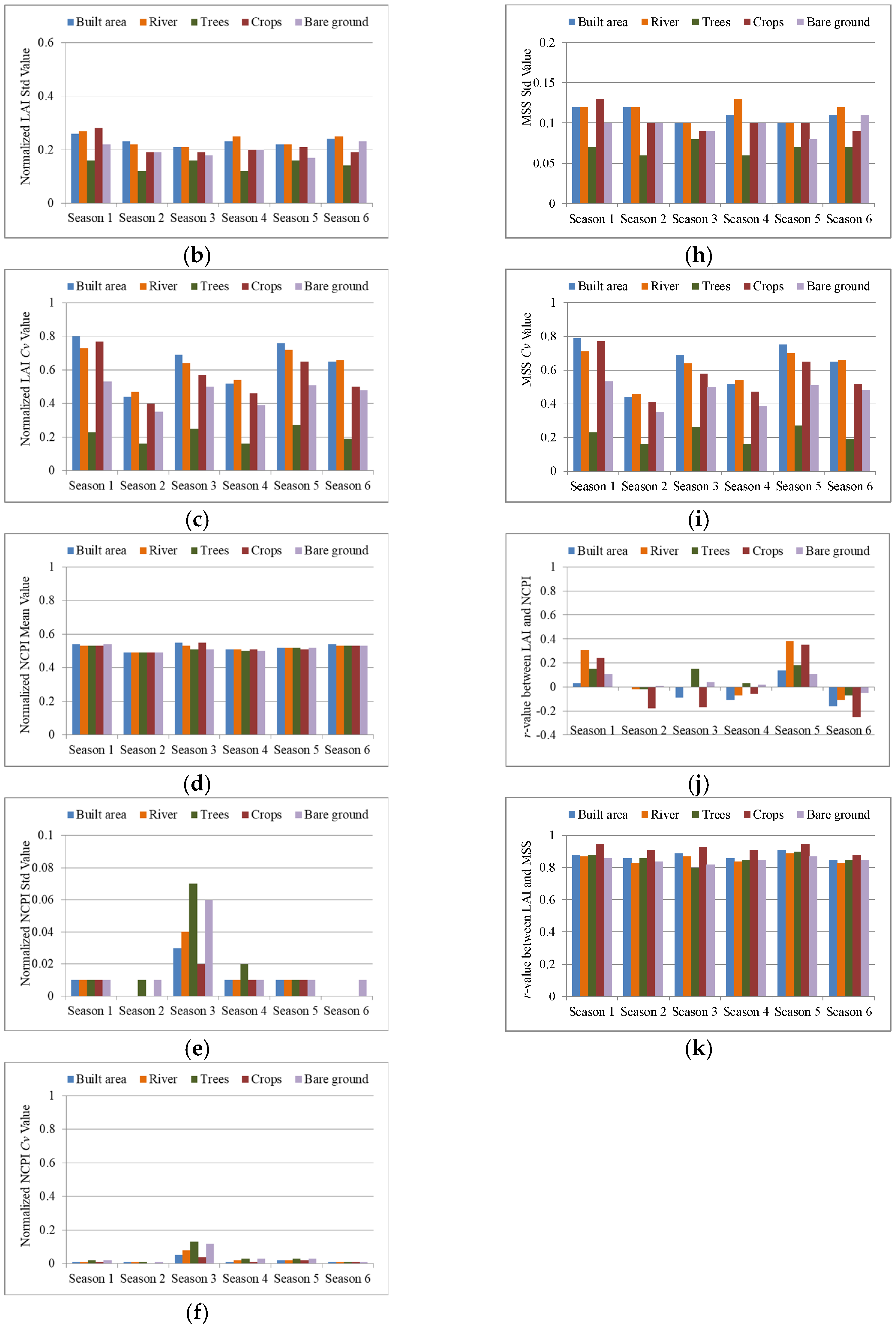
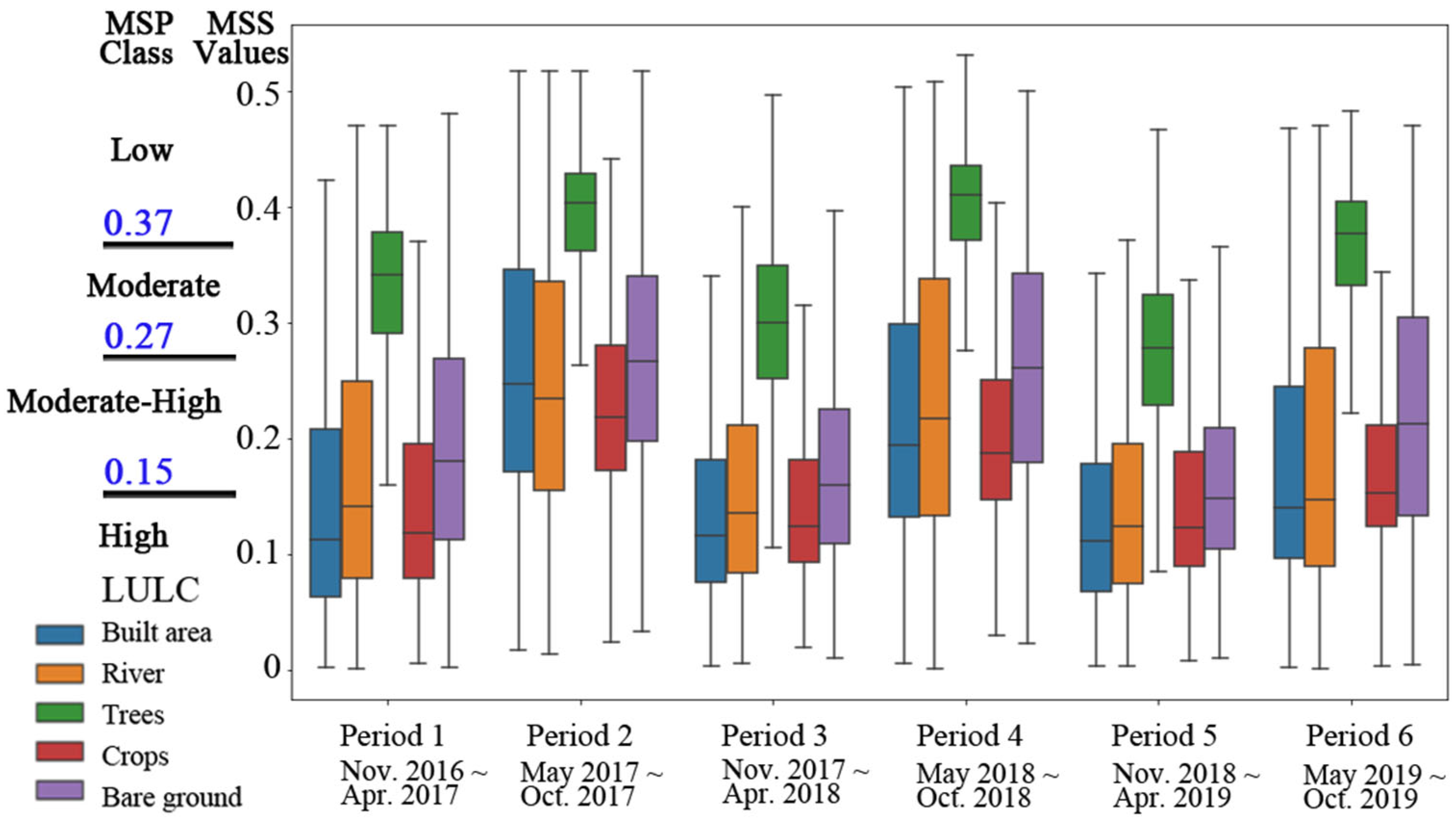
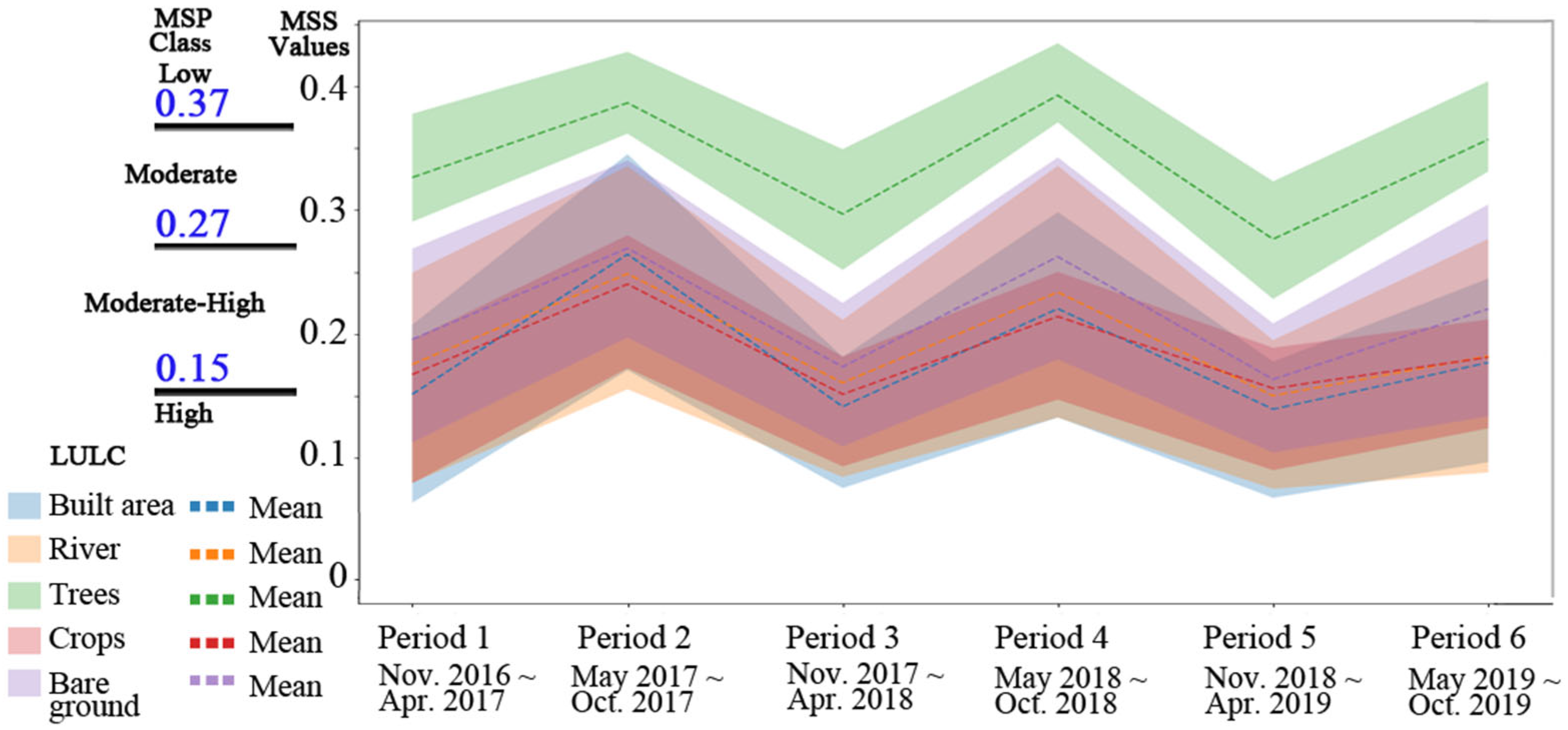
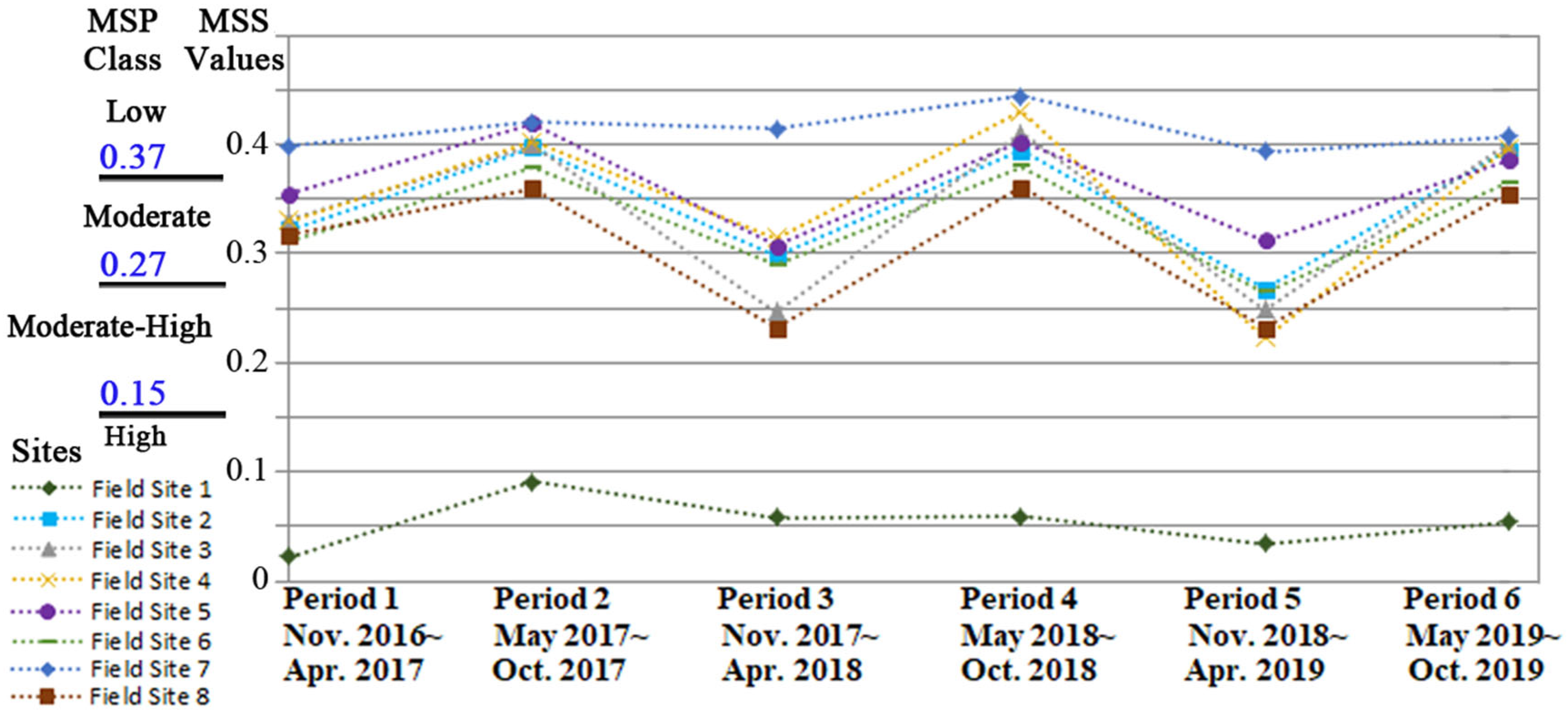
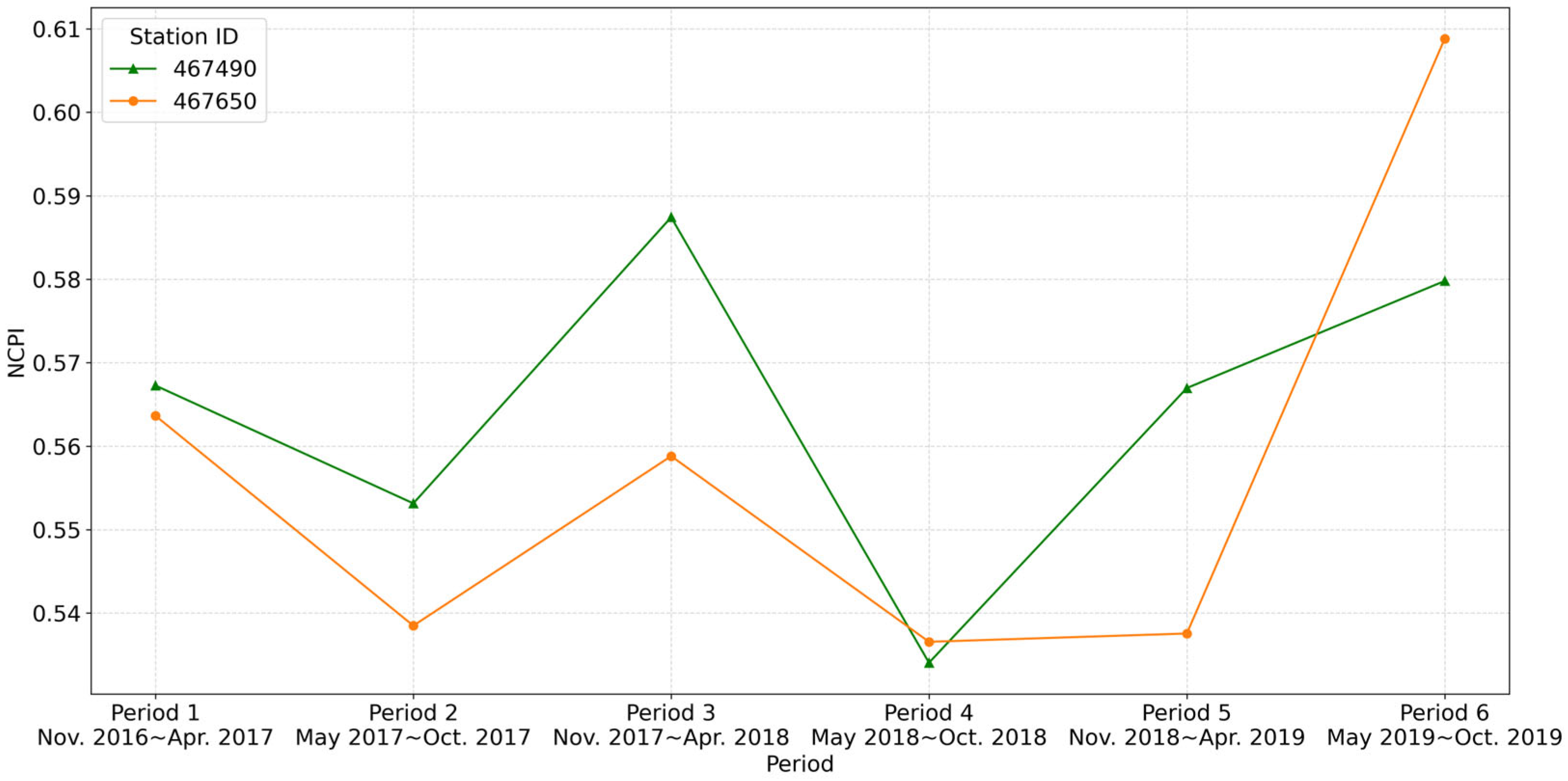

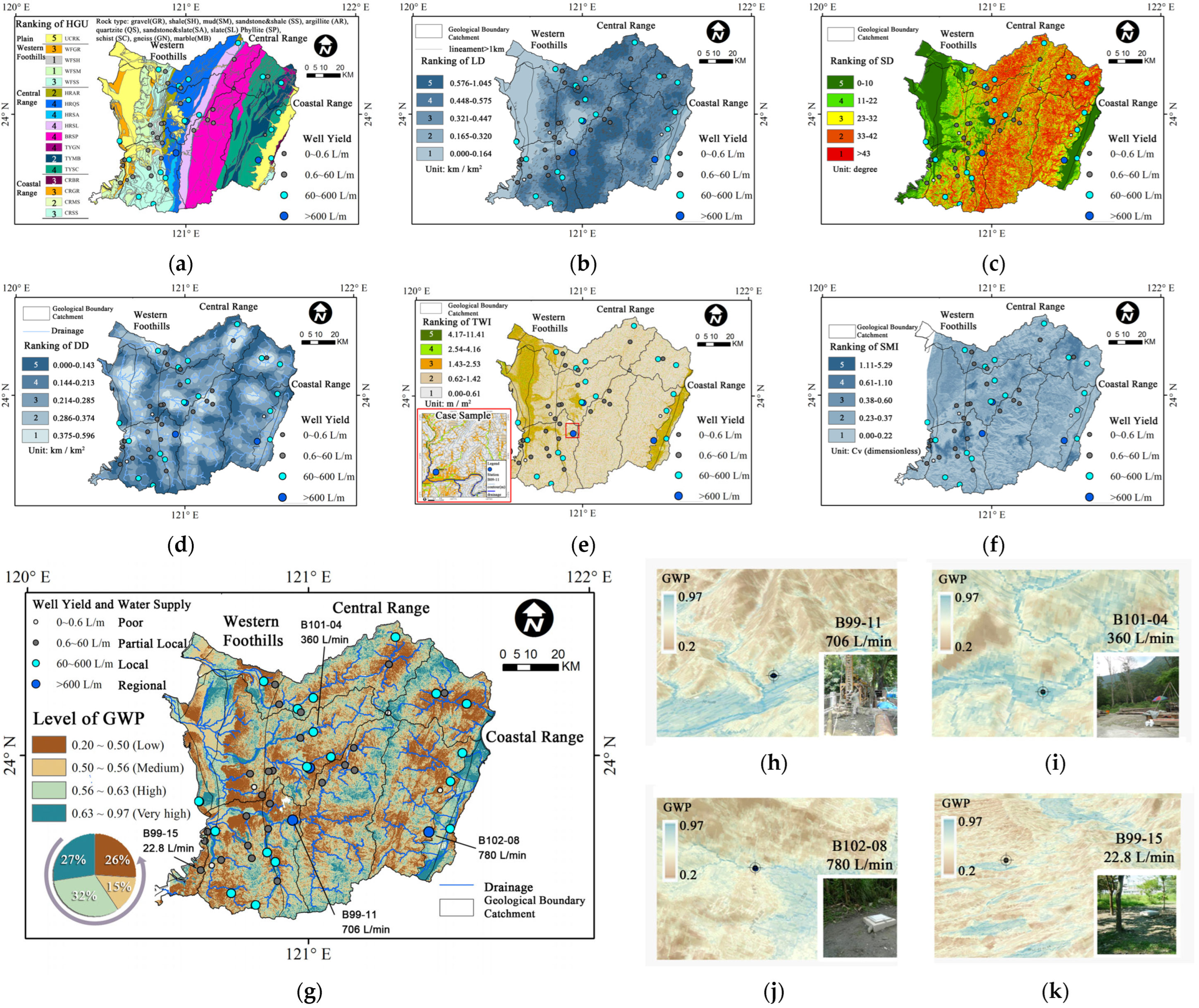
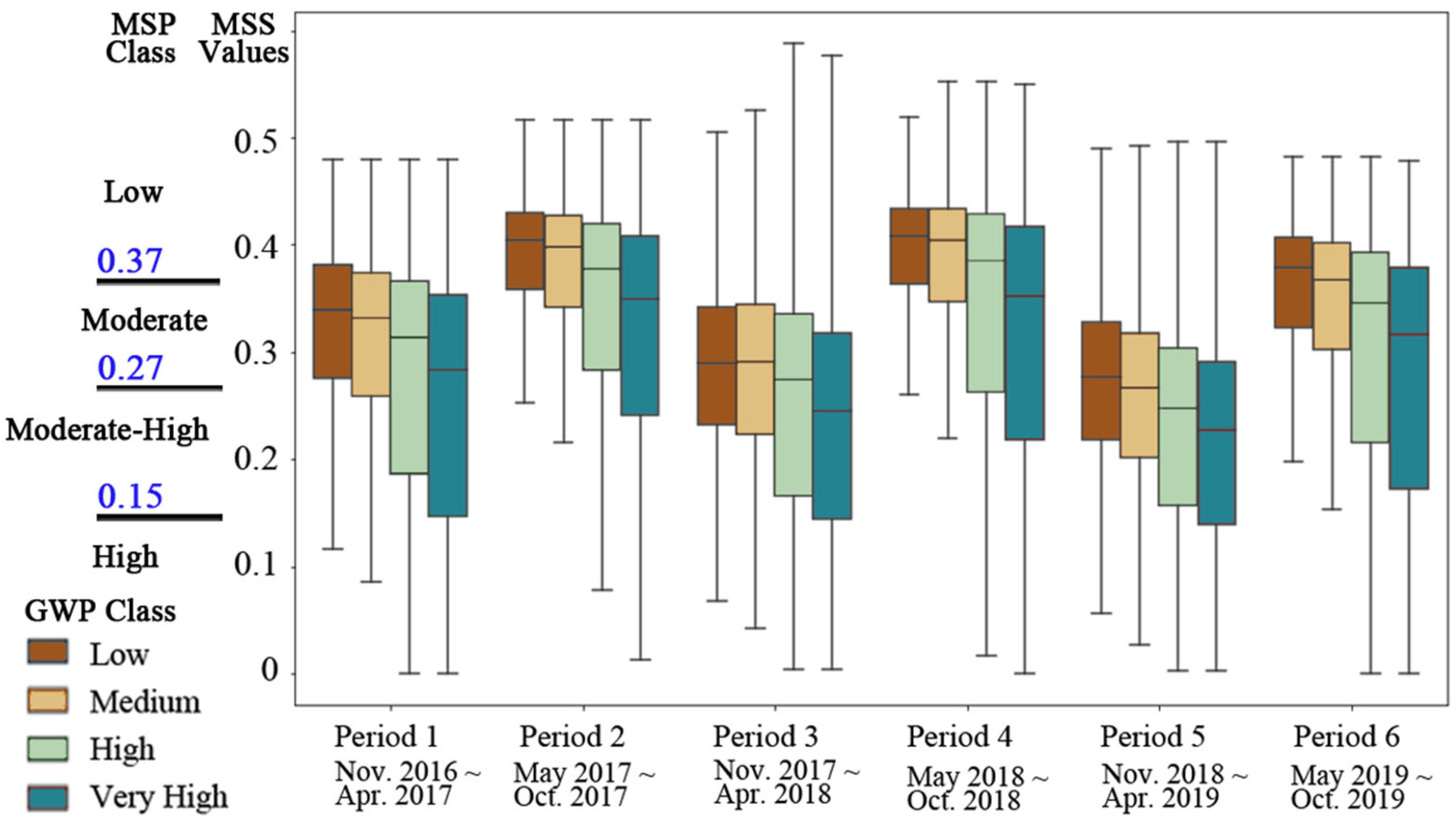
| No * | X (WGS 84) | Y (WGS 84) | Elevation (m) | Landscape Description |
|---|---|---|---|---|
| 1 | 120.6487 | 24.0419 | 52 | Urban and crop in the urban basin |
| 2 | 120.6752 | 23.74698 | 173 | Riverbed and grassland in the plain |
| 3 | 120.8068 | 24.21523 | 485 | Broad-leaved forests, bamboo forests, and crops in hilly terrain |
| 4 | 120.8823 | 23.66554 | 879 | Broad-leaved forests and riverbed vegetation in diverse terrains |
| 5 | 120.9657 | 23.88429 | 676 | Mixed coniferous and broad-leaved forests in moist, cloud-rich environments at high elevations |
| 6 | 121.2307 | 24.28666 | 2141 | Mixed coniferous and broad-leaved forests and crops on steep high-mountain slopes |
| 7 | 121.568 | 24.17034 | 563 | Mixed coniferous and broad-leaved forests with grassland facilities |
| 8 | 121.261 | 24.1534 | 2933 | Coniferous forests and alpine grasslands in the Hehuan Mountains, ranging from 3145 to 3422 m in elevation. The Hehuan Mountains are ranked in the second quartile of Taiwan’s top 100 mountains, with snow observed during winter |
| Method | Data Requirements | Spatial Coverage | Limitations |
|---|---|---|---|
| Remote Sensing—Backscatter | Radar backscatter, vegetation index | Regional to global | Affected by vegetation structure, roughness, and calibration complexity |
| Remote Sensing—Brightness Temperature | Thermal IR data, surface emissivity | Global | Sensitive to cloud cover, emissivity variations |
| Energy Balance Models | Radiation (net, solar), temperature, wind speed, humidity | Local to regional | Requires high-resolution input and meteorological instrumentation |
| Empirical Dew Models | Air temperature, relative humidity, cloud cover, empirical coefficients | Local to regional | Designed for site-specific scenarios, and may require adaptation |
| Psychrometric Chart-Based Estimation | Temperature, dew point, relative humidity (standard field data) | Regional | Assumes near-saturation conditions; simplified condensation threshold logic |
| NCPI (1) | LAI (2) | LCP (1) × (2) | Dew Potential on Leaves | 1 − NCPI (3) | LAI (4) | MSS (3) × (4) | MSP (Priority Level) | Interpretation |
|---|---|---|---|---|---|---|---|---|
| 0.8 | 0.8 | 0.64 | High | 0.2 | 0.8 | 0.16 | Moderate | Weather conditions are already optimal; further interventions yield minimal benefits. |
| 0.8 | 0.2 | 0.16 | Moderate | 0.2 | 0.2 | 0.04 | High | Weather conditions are favorable, but ecological potential is limited; active management is prioritized. |
| 0.2 | 0.8 | 0.16 | Moderate | 0.8 | 0.8 | 0.64 | Low | Weather conditions are poor, but ecological potential is strong; site remains valuable for targeted management. |
| 0.2 | 0.2 | 0.04 | Low | 0.8 | 0.2 | 0.16 | Moderate | Both weather conditions and ecological potential are low; represents a trade-off zone requiring cautious consideration. |
| Study Parameters | Value |
|---|---|
| Radius of filter in pixels | 5 |
| Threshold for edge gradient | 15 |
| Threshold for curve length | 3 |
| Threshold for line fitting error | 3 |
| Threshold for angular difference | 10 |
| Threshold for linking distance | 10 |
| Period | Model | Sill | Range | Nugget | RMSE |
|---|---|---|---|---|---|
| Cold Season between November 2016 and April 2017 | Spherical | 0.0044 | 95,157.45 | 0.0018 | 0.0753 |
| Exponential | 0.0030 | 447,748.3 | 0.0039 | 0.0737 | |
| Gaussian | 0.0023 | 447,748.3 | 0.0049 | 0.0785 | |
| Warm Season between April 2017 and October 2017 | Spherical | 0.0027 | 33,694.8 | 0.0015 | 0.0703 |
| Exponential | 0.0027 | 1.95 | 0.0015 | 0.0696 | |
| Gaussian | 0.0027 | 1102.95 | 0.0015 | 0.0691 | |
| Cold Season between November 2017 and April 2018 | Spherical | 0.0065 | 46,351.91 | 0.0032 | 0.0859 |
| Exponential | 0.0065 | 676.73 | 0.0032 | 0.1028 | |
| Gaussian | 0.0064 | 6861.23 | 0.0033 | 0.0917 | |
| Warm Season between April 2018 and October 2018 | Spherical | 0.0023 | 34,582.23 | 0.0017 | 0.0719 |
| Exponential | 0.0023 | 1.16 | 0.0017 | 0.0667 | |
| Gaussian | 0.0023 | 0.02 | 0.0018 | 0.0659 | |
| Cold Season between November 2018 and April 2019 | Spherical | 0.0066 | 49,872.83 | 0.0038 | 0.1032 |
| Exponential | 0.0064 | 1163.55 | 0.0040 | 0.1037 | |
| Gaussian | 0.0065 | 3243.23 | 0.0039 | 0.1064 | |
| Warm Season between April 2019 and October 2019 | Spherical | 0.0035 | 66,702.53 | 0.0030 | 0.0867 |
| Exponential | 0.0016 | 447,748.3 | 0.0053 | 0.0923 | |
| Gaussian | 0.0034 | 54,791.74 | 0.0031 | 0.0828 |
| LAI Class/Value Range | Threshold Values of LAI (Mean Values) | (a) | (b) | (c) | (d) | (e) | (f) |
|---|---|---|---|---|---|---|---|
| Low | 0.00–0.31 | 0.00–0.28 | 0.00–0.34 | 0.00–0.31 | 0.00–0.34 | 0.00–0.30 | 0.00–0.26 |
| Moderate | 0.31–0.54 | 0.28–0.54 | 0.34–0.56 | 0.31–0.53 | 0.34–0.58 | 0.30–0.52 | 0.26–0.51 |
| Moderate–High | 0.54–0.76 | 0.54–0.76 | 0.56–0.76 | 0.53–0.74 | 0.57–0.78 | 0.52–0.73 | 0.51–0.76 |
| High | 0.76–1.00 | 0.76–1.00 | 0.76–1.00 | 0.74–1.00 | 0.78–1.00 | 0.73–1.00 | 0.76–1.00 |
| MSP Class/Value Range | Threshold Values of MSS (Mean Values) | (a) | (b) | (c) | (d) | (e) | (f) |
|---|---|---|---|---|---|---|---|
| High | 0.00–0.15 | 0.00–0.14 | 0.00–0.18 | 0.00–0.15 | 0.00–0.17 | 0.00–0.14 | 0.00–0.13 |
| Moderate–High | 0.15–0.27 | 0.14–0.26 | 0.18–0.29 | 0.15–0.26 | 0.17–0.29 | 0.14–0.25 | 0.13–0.25 |
| Moderate | 0.27–0.37 | 0.26–0.36 | 0.29–0.39 | 0.26–0.36 | 0.29–0.39 | 0.25–0.34 | 0.25–0.36 |
| Low | 0.37–0.54 | 0.36–0.50 | 0.39–0.53 | 0.36–0.61 | 0.39–0.58 | 0.34–0.50 | 0.36–0.50 |
Disclaimer/Publisher’s Note: The statements, opinions and data contained in all publications are solely those of the individual author(s) and contributor(s) and not of MDPI and/or the editor(s). MDPI and/or the editor(s) disclaim responsibility for any injury to people or property resulting from any ideas, methods, instructions or products referred to in the content. |
© 2025 by the authors. Licensee MDPI, Basel, Switzerland. This article is an open access article distributed under the terms and conditions of the Creative Commons Attribution (CC BY) license (https://creativecommons.org/licenses/by/4.0/).
Share and Cite
Lin, J.-J.; Arslan, A.N. LAI-Derived Atmospheric Moisture Condensation Potential for Forest Health and Land Use Management. Remote Sens. 2025, 17, 2104. https://doi.org/10.3390/rs17122104
Lin J-J, Arslan AN. LAI-Derived Atmospheric Moisture Condensation Potential for Forest Health and Land Use Management. Remote Sensing. 2025; 17(12):2104. https://doi.org/10.3390/rs17122104
Chicago/Turabian StyleLin, Jung-Jun, and Ali Nadir Arslan. 2025. "LAI-Derived Atmospheric Moisture Condensation Potential for Forest Health and Land Use Management" Remote Sensing 17, no. 12: 2104. https://doi.org/10.3390/rs17122104
APA StyleLin, J.-J., & Arslan, A. N. (2025). LAI-Derived Atmospheric Moisture Condensation Potential for Forest Health and Land Use Management. Remote Sensing, 17(12), 2104. https://doi.org/10.3390/rs17122104







